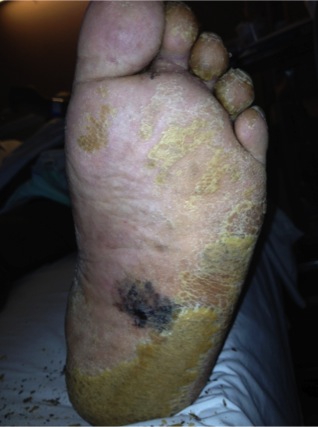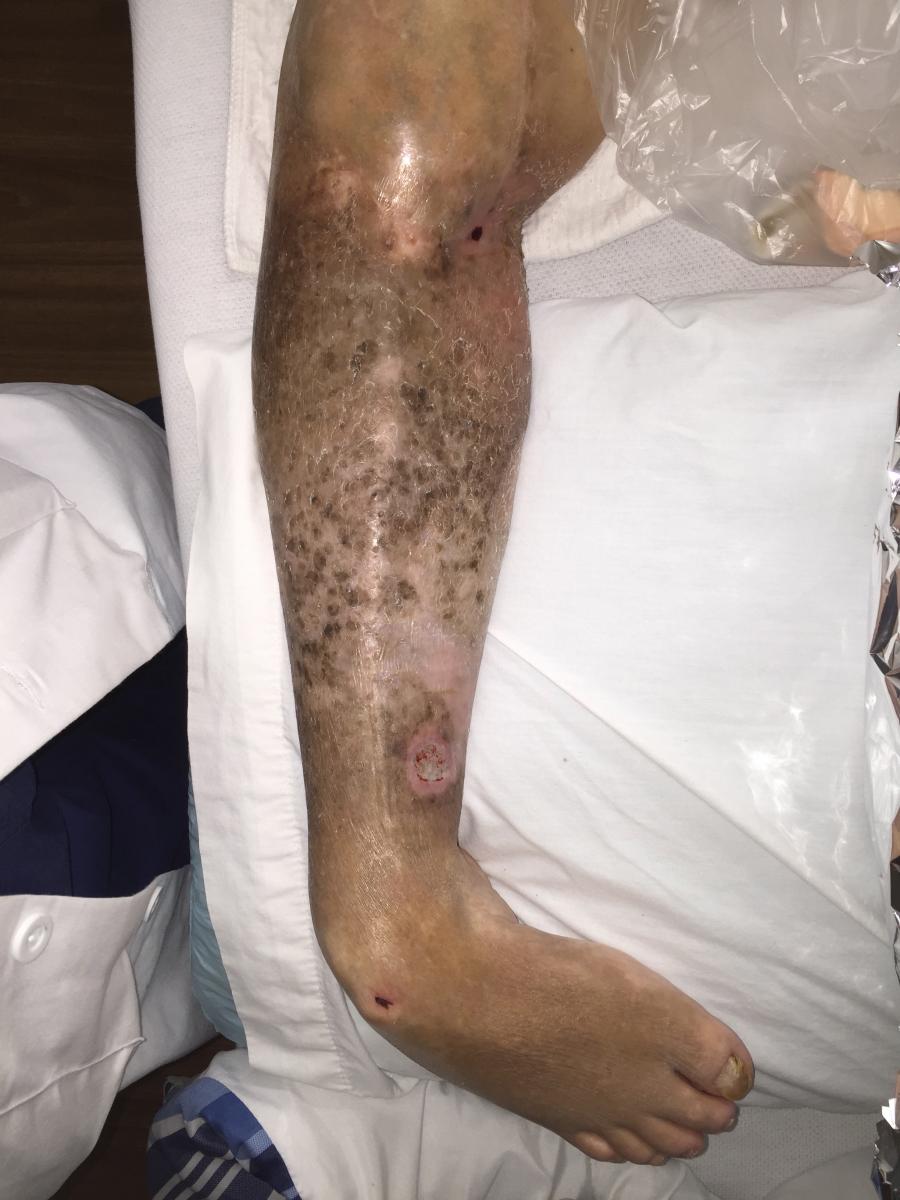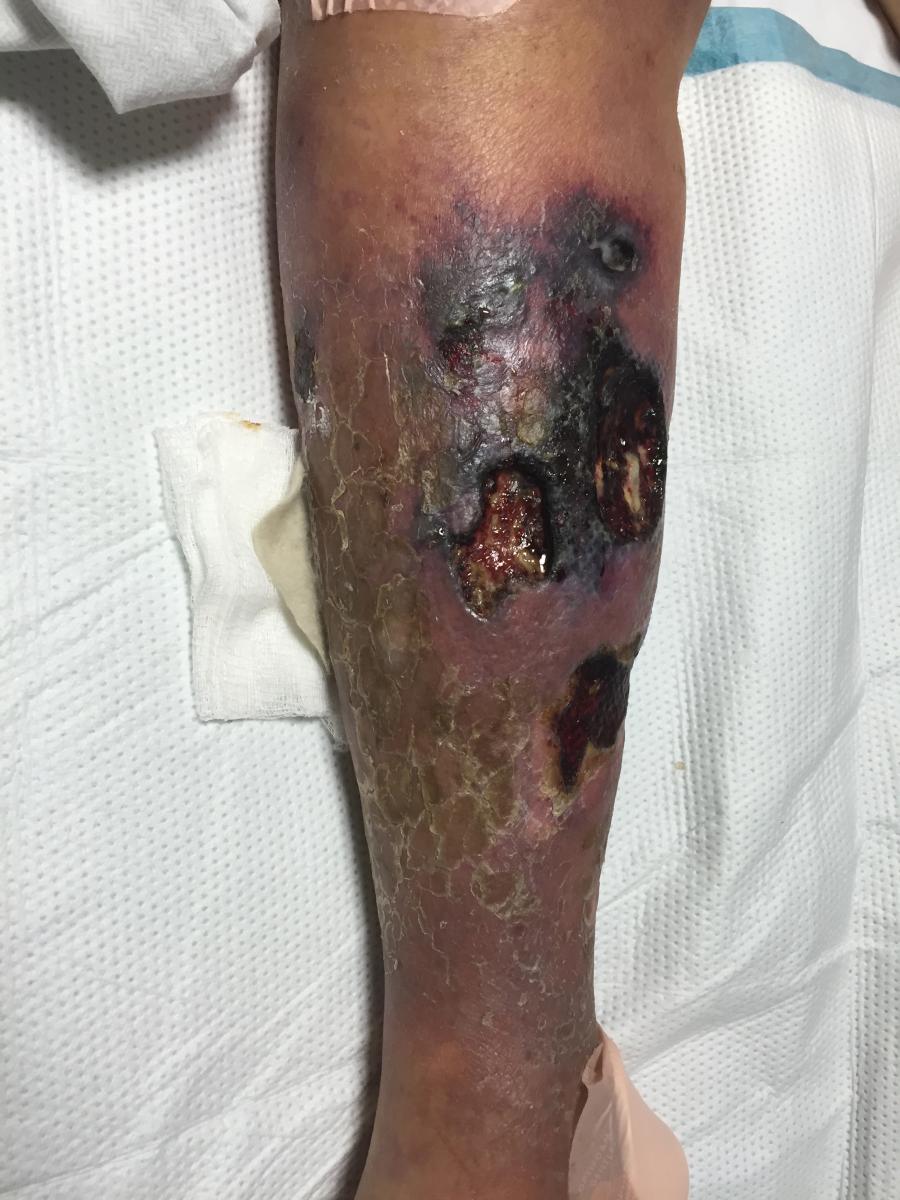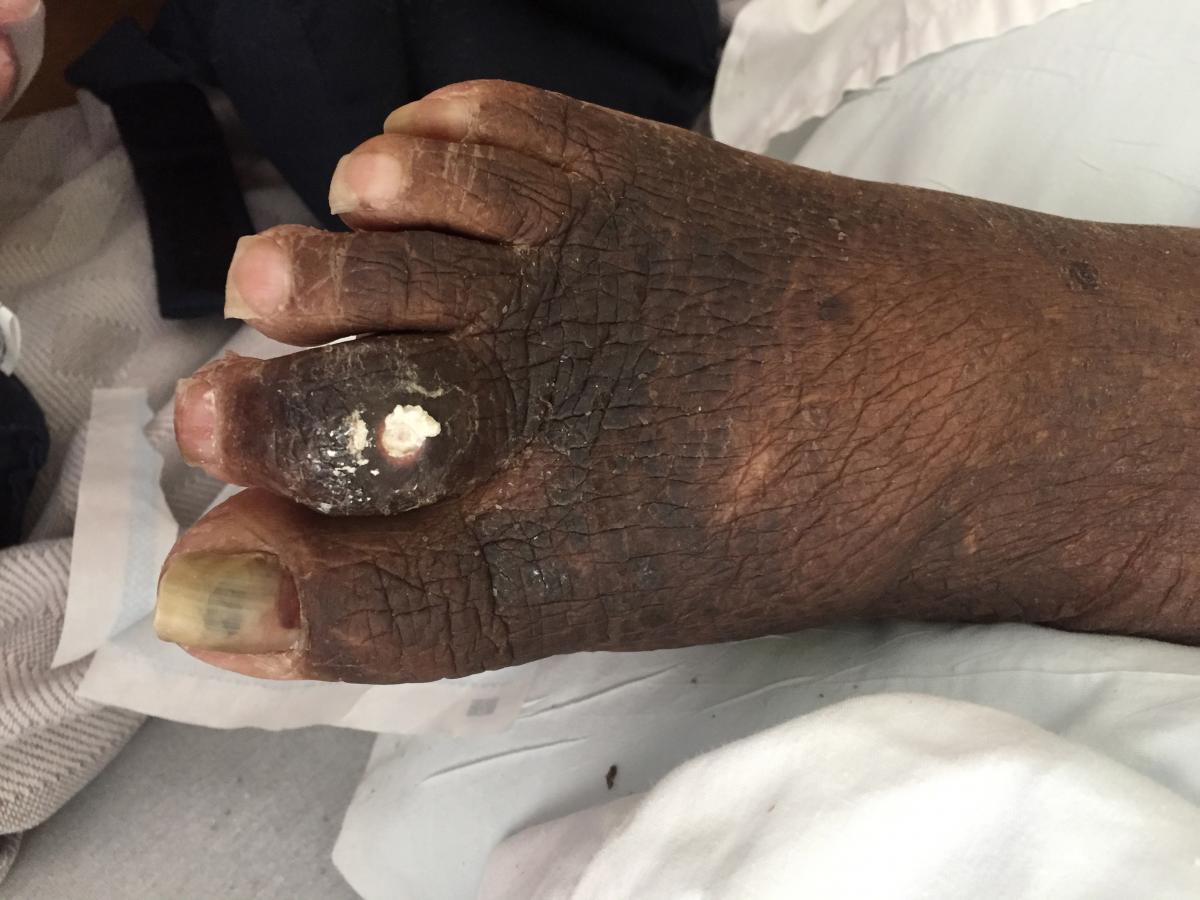ADVERTISEMENT
Keys To The Workup For Chronic Ulcers In Patients Referred By Other Physicians
 Due to the expertise of podiatric physicians in treating lower extremity wounds, other physicians may refer patients with chronic ulcers to DPMs. Accordingly, this author emphasizes the importance of obtaining previous medical records, relevant keys to the patient history, ascertaining the cause(s) of the wound and pertinent diagnostic testing.
Due to the expertise of podiatric physicians in treating lower extremity wounds, other physicians may refer patients with chronic ulcers to DPMs. Accordingly, this author emphasizes the importance of obtaining previous medical records, relevant keys to the patient history, ascertaining the cause(s) of the wound and pertinent diagnostic testing.
There are currently 3 to 6 million people in the United States with chronic, non-healing ulcers with a cost of more than $3 billion per year.1,2 Podiatrists are likely getting more chronic wound referrals as the most common types of chronic wounds are of the lower extremities.3,4 Of these ulcers, 98 percent are generally vascular or diabetic in etiology, and 85 percent affect patients who are 65 years old and older.1-4
We can consider ulcers to be chronic if they have not gone through an orderly and timely reparative process to produce anatomic and functional integrity over a period of three months, or have not had a 15 percent reduction weekly or approximately 50 percent reduction of the surface area over a one-month period.3,5-7 The number of chronic wounds insufficiently treated over long periods of time is increasing worldwide.3,8
Chronic ulcers are characterized by having raised, non-advancing wound margins with senescent fibroblasts that do not sufficiently respond to normal stimulatory messages.2,3,5,9 In addition, chronic ulcers are in a constant inflammatory state characterized by the presence of proinflammatory cytokines and excess matrix metalloproteinases (MMPs), resulting in the destruction of the extracellular matrix.2,3 This chronic inflammation is a significant factor in delayed healing and can also predispose these ulcers to malignant change over time.
Determining the etiology of the ulcer as well as local and systemic factors that are contributing to poor wound healing is essential to successful wound treatment.2-5 In regard to the workup of a chronic ulcer that another physician referred, the main keys for success are contacting the referring physician, obtaining adequate past medical records, taking a detailed wound history and performing a thorough assessment of the wound with proper documentation and photographs. Other keys are determining the most likely etiology, evaluating the arterial blood flow, testing for infection, evaluating/ordering relevant imaging, performing a biopsy if warranted, getting basic blood work and making the appropriate referrals to other specialists.
Contacting The Referring Physician And Obtaining Past Medical Records
Prior to attempting to get any medical records, make sure the patient signs a medical records release consent and that the practice is following all HIPAA laws.
 Whenever you get a new referral, always attempt to speak to the referring physician on the phone if possible. The physician will likely have important information that is not in the patient’s chart, which will help with forming a new treatment plan. This will also help foster relationships that can lead to more referrals in the future and better patient outcomes.
Whenever you get a new referral, always attempt to speak to the referring physician on the phone if possible. The physician will likely have important information that is not in the patient’s chart, which will help with forming a new treatment plan. This will also help foster relationships that can lead to more referrals in the future and better patient outcomes.
There are also several new programs and phone apps physicians can use to send and get referrals. Although this technology is extremely new, it could be a better and more efficient way to obtain a new patient’s prior records from a referring physician in the future. Many electronic medical record (EMR) systems have built-in functions to easily transfer patient records as well.
Examples of information that one needs to obtain include but are not limited to prior progress notes, X-rays, culture results (wound, urine, blood and Clostridium difficile), pathology reports, recent lab tests, list of prior surgeries (with dates), vascular specialist records, infectious disease physician records, and any pertinent prior hospitalization records.10
Ensuring A Detailed Patient History
Taking a detailed history is paramount in determining the correct diagnosis and treatment plan for a patient referred by another physician. Basic questioning includes subjects like the duration of the wound, initial event or trauma, and increase or decrease in wound size. Also determine the past treatment and most current treatment. Finally, discern the amount, type, quality and intensity of pain present, and any prior ulcers/wounds in the past. If there were previous ulcers, one should note what helped heal the wounds and what caused them.10
A thorough examination of the patient’s past medical history is also extremely important. Does the patient have any medical conditions such as diabetes, peripheral arterial disease or chronic kidney disease that are associated with non-healing wounds?10 Are there problems with immobility, lymphedema, cancer or mental illness?
Surgical history can also help with determining your treatment plan. Has the patient had any skin grafts or skin substitutes? Has there been any peripheral artery endovascular intervention, arterial bypass, venous ablation, biopsy or radiation treatment?10
Physicians often overlook allergies but one needs to evaluate these. Many conditions and wounds can be directly related to a patient’s allergies. This is especially true with allergies to adhesives and certain agents used in topical medications.
The patient’s medication list can also help in getting a correct diagnosis and appropriate treatment plan. Is the patient already on antibiotics? If the patient is on blood thinners, then one may need to take more care while doing biopsies or debridement. Some medications such as hydroxyurea can cause non-healing ulcerations of the lower extremities. In addition, if the patient is taking chronic steroids, non-steroidal anti-inflammatory drugs (NSAIDs) or chemotherapy drugs, this can also delay healing in wounds and one may need to address this to help with wound healing.11
 The social history can also give clues as to why the patient is not healing. If the patient currently smokes, then healing will be impaired.12 The patient will need counseling and referral to a smoking cessation course. If the patient is a former heavy smoker, he or she may already have artery damage.13 Is the patient an alcoholic? Alcoholism can cause lower extremity neuropathy and a suppressed proinflammatory cytokine release in response to an inflammatory challenge, which can lead to non-healing ulcers.14,15 Does the patient live alone or does he or she have help at home? This will be important information for patients who need to remain non-weightbearing or keep their legs elevated as people without help have more difficulty taking care of themselves. Does the patient work or stand up all day?10
The social history can also give clues as to why the patient is not healing. If the patient currently smokes, then healing will be impaired.12 The patient will need counseling and referral to a smoking cessation course. If the patient is a former heavy smoker, he or she may already have artery damage.13 Is the patient an alcoholic? Alcoholism can cause lower extremity neuropathy and a suppressed proinflammatory cytokine release in response to an inflammatory challenge, which can lead to non-healing ulcers.14,15 Does the patient live alone or does he or she have help at home? This will be important information for patients who need to remain non-weightbearing or keep their legs elevated as people without help have more difficulty taking care of themselves. Does the patient work or stand up all day?10
Assessing Wounds With Proper Documentation And Photographs
A thorough clinical assessment of the chronic ulcer will help determine the true etiology of the wound and help with the formulation of a new treatment plan. Document the ulcer location, length, width, depth, position and depth of undermining; the presence of cellulitis; and drainage amount, type, color and odor. Note the deepest level of tissue penetration. A metal-tipped probe is more useful in a probe-to-bone test as a wooden probe often does not adequately differentiate between bone and other periosseous structures.10
With the patient’s consent, take photographs of all the wounds at every visit, both pre- and post-debridement. The pictures should include a measuring strip, the date and the patient’s initials or other medical modifier. Make sure the photos are clear and high resolution. Adequate photographs will help with better monitoring of the patient’s progress in the future. In addition, you can add the photos to your medical note and with some systems, you can send them back to your referring physician. This will allow the referring physician to see the progress the patient’s wounds make over time.16
With the advent and widespread use of smartphones, most patients also have their own photographs of their wounds that they have taken themselves. With permission, examine these photos and place them into the patient’s medical chart. By evaluating the older photos, a physician can better understand and visualize the trajectory of the patient’s wound healing or non-healing, and better formulate a plan to help with wound closure.
 Determining The Most Likely Wound Etiology
Determining The Most Likely Wound Etiology
The majority of lower extremity wounds are venous, pressure-related, diabetic, ischemic, surgical or traumatic in nature. A thorough workup will help exclude less common etiologies such as malignancy, sickle cell ulcer, pyoderma gangrenosum, IgA monoclonal gammopathies, Wegener’s granulomatosis, cutaneous chronic granulomatous disease, mycobacterial etiology, fungal etiology, thromboangiitis, vasculitis, Raynaud’s phenomenon, thalassemia, Martorell hypertensive ulcers, and calciphylaxis.4,10
Venous ulcers typically arise between the knee and ankle with the medial and lateral malleoli being the most common sites.10 There is often beefy, red granulation tissue present and minimal pain (severe pain may indicate infection or alternative etiology). The surrounding skin often has hyperpigmentation, lipodermatosclerosis, stasis dermatitis and pruritus.
Pressure ulcers are typically located over bony prominences.10 There may be granulation tissue, fibrotic tissue or necrotic eschar present. Many pressure ulcers present with deep probing to bone, undermining and periwound erythema. Pain levels can vary.
Diabetic foot ulcers are typically located in areas of repeated trauma, such as the plantar metatarsal heads, dorsal interphalangeal joints and toe tips.10 There is typically a red or pink granular base with undermining borders covered with hyperkeratotic tissue. Diabetic ulcers are usually painless due to sensorimotor peripheral neuropathy. However, minimal pain can be present in some patients.
Ischemic ulcers are typically located in prominent osseous areas or areas of pressure and skin shearing. Common sites include toe tips, the lateral malleolus, the leg and between the toes. The ulcers are usually sharply demarcated, have punched-out margins and may have a pale wound bed with minimal granulation tissue, yellow fibrotic tissue or dry necrotic eschar. The surrounding skin may be shiny, tight, blanched or purpuric with loss of hair growth. Ischemic ulcers are usually painful, which may be aggravated by elevation and relieved with a dependent leg position.10
A Primer On Essential Diagnostic Testing
Basic testing is imperative in the workup for a patient with a chronic non-healing ulcer, even if another physician referred the patient. Never assume that the patient’s prior testing was correct or accurate. Conducting your own testing may have different results than your referral source, which can aid with healing the patient.
Arterial blood flow evaluation. Use a handheld Doppler on all new patients with chronic ulcers to help evaluate the lower extremity arterial flow. Physical findings such as poor capillary refill, thin atrophic skin or hypertrophic nails may also indicate arterial obstruction.10 If the Doppler or physical exam notes any abnormalities associated with peripheral arterial disease, then an immediate referral to a vascular specialist is necessary. One should obtain an ankle-brachial index (ABI), if available, for every patient as well as a tibial-brachial index (TBI) for all patients with diabetes and those with renal disease.4
 Test for infection. Almost all ulcers are colonized with bacteria. Therefore, the diagnosis of an acute infection is a clinical diagnosis and not a microbiological diagnosis.10 Signs and symptoms that suggest the presence of infection that may require hospitalization, IV antibiotics and/or debridement include increasing erythema of the surrounding skin of more than 2 cm, induration, lymphangitis, an increase in ulcer size, a large amount of drainage, fever and wound odor.10,17
Test for infection. Almost all ulcers are colonized with bacteria. Therefore, the diagnosis of an acute infection is a clinical diagnosis and not a microbiological diagnosis.10 Signs and symptoms that suggest the presence of infection that may require hospitalization, IV antibiotics and/or debridement include increasing erythema of the surrounding skin of more than 2 cm, induration, lymphangitis, an increase in ulcer size, a large amount of drainage, fever and wound odor.10,17
Only obtain wound cultures if there are signs of an acute infection. Take the sample after debriding and cleansing the wound. A deep tissue culture is preferable to superficially swabbing the wound base or drainage. This will help in more effectively guiding antibiotic therapy.10,18,19,20
Imaging studies. Always obtain new X-rays to evaluate the underlying bony structures for any tumors, infection, fractures, gas, bony deformities or foreign bodies as all of these pathologies have a role in the workup of a chronic ulceration. Compare the new X-rays to any prior X-rays available to evaluate for any bony or soft tissue changes.
If there is concern for an abscess or osteomyelitis, clinically or from evaluation of X-rays, then magnetic resonance imaging (MRI), computed tomography (CT) scans or a radionuclide scan may be appropriate imaging for a new patient. Advanced imaging can help with surgical and antibiotic duration planning.
Biopsy. Consider a biopsy in any wound that has been present for longer than three months. This will help rule out squamous cell carcinoma, melanoma and other malignancies.10 In addition, an appropriate biopsy can help rule out certain collagen vascular diseases and other rare diseases.10,21
What The Blood Work Analysis Can Reveal
Basic blood work that one should consider for workup of a chronic ulcer includes a complete blood cell (CBC) count, basic metabolic panel, liver function test, HbA1c, albumin, pre-albumin and sickle cell prep.4,10 This simple panel can give you a very good overview of the patient’s overall health. With this new information, you can make referrals to the appropriate providers more easily.
An elevated HbA1c will give insight on how well the patient controls his or her diabetes. If the HbA1c is elevated, then wound healing will be impaired. Specifically, for each 1 percent increase in HbA1c, the daily wound area healing rate decreases by 0.028 cm2/day. The patient will need referral to an endocrinologist to help decrease the HbA1c to help with healing.22
Albumin and pre-albumin are useful in determining the patient’s overall nutrition status. Adequate nutrition is important for wound healing and to help address potential wound complications.10 Malnutrition commonly manifests in patients with an immunosuppressed state, malignancies, traumas or gastrointestinal disorders, and in patients with chronic and systemic diseases.3 Patients may need protein supplementation or dietitian referral or, in extreme cases, referral to a gastroenterologist for implantation of a feeding tube.
 If sickle cell disease is a differential diagnosis, then one will need to order a sickle cell prep and hemoglobin electrophoresis. Patients with sickle cell disease have difficulty healing wounds and will often require referral to a hematologist for medication adjustments to help with healing. Approximately 5 to 7 percent of the global population carries an abnormal hemoglobin gene with sickle cell disease being the most prevalent.23
If sickle cell disease is a differential diagnosis, then one will need to order a sickle cell prep and hemoglobin electrophoresis. Patients with sickle cell disease have difficulty healing wounds and will often require referral to a hematologist for medication adjustments to help with healing. Approximately 5 to 7 percent of the global population carries an abnormal hemoglobin gene with sickle cell disease being the most prevalent.23
A Guide To Making Additional Appropriate Referrals
Depending on your findings, the patient may require referrals to other specialists. Part of modern medicine is using the team approach. By utilizing the skills of other physicians, you can often get better care for your patient.
If there is osteomyelitis or a culture with a high level of resistance, consider a consultation to an infectious disease specialist. The infectious disease physician can help manage any IV antibiotics and associated lab work. He or she can also help coordinate with the patient’s home health company or local infusion center.
If there is evidence or suspicion of peripheral arterial disease, then the patient needs an immediate referral to a vascular surgeon or interventional cardiologist. The earlier a physician can restore the blood flow, the earlier the patient can heal and, in many cases, the less likely he or she will need a more proximal amputation.
 If lower extremity venous disease is evident, make a referral to a vein specialist. With all of the new interventions and surgeries available, these physicians can improve the venous disease, which will aid in healing your patient faster. This can also possibly help prevent future venous ulcerations for your patient.
If lower extremity venous disease is evident, make a referral to a vein specialist. With all of the new interventions and surgeries available, these physicians can improve the venous disease, which will aid in healing your patient faster. This can also possibly help prevent future venous ulcerations for your patient.
A referral to a pedorthist or durable medical equipment (DME) provider may be necessary to obtain certain specialty items. By developing good relationships with these specialists, you can usually attain what your patient needs more efficiently. This includes controlled ankle motion (CAM) walkers, knee walkers, specialty beds/specialty mattresses, heel protectors, wheelchairs, lymphedema pumps and compression stockings.
If the non-healing ulcer is a diabetic ulcer (Wagner grade 3 and higher), has chronic osteomyelitis, is secondary to a compromised skin flap, is associated with soft tissue radionecrosis or is associated with peripheral arterial disease (PAD), then, depending on your local coverage determination (LCD), referral to a wound center with hyperbaric oxygen therapy is appropriate to help with healing. For appropriate ulcers, hyperbaric oxygen therapy (HBOT) has proven to be a useful adjunctive therapy to help with healing.24
Other specialists that may require consultation include home health agencies to help with dressing changes, therapy and IV antibiotics; neurologists for pain management and onabotulinumtoxinA (Botox, Allergan) injections for limb contractures; a nutritionist/dietician for help with weight loss and better nutrition; physical therapists for gait training; or a plastic surgeon to aid in free flap surgery or reconstruction.
In Conclusion
After finishing a complete workup, one can formulate the treatment plan and tailor it to the findings using the standards of care established for the etiology/etiologies of the ulceration. This, in turn, can lead to quicker healing, fewer amputations and higher patient satisfaction. This will likely impress your referral source and increase the number of referrals you receive in the future.
Dr. Swain is a board certified wound specialist physician (CWSP) of the American Board of Wound Management, and a Diplomate of the American Board of Podiatric Medicine. He is the Medical Director of the St. Vincent’s Wound Care and Hyperbaric Center at St. Vincent’s Southside Hospital, and is in private practice in Jacksonville, Fla.
References
- Mathieu D, Linke JC, Wattel F. Non-healing wounds. In: Handbook on Hyperbaric Medicine, Mathieu DE (ed.). Springer, Netherlands, 2006, pp. 401–427.
- Menke NB, Ward KR, Witten TM, et al. Impaired wound healing. Clin Dermatol. 2007; 25(1):19–25.
- Werdin F, Tennenhaus M, Schaller HE, Rennekampff HO. Evidence-based management strategies for treatment of chronic wounds. Eplasty. 2009; 9:e19.
- Robson MC, Barbul A. Guidelines of the best care of chronic wounds. Wound Repair Regen. 2006; 14(6):647–710.
- Mustoe TA, O’Shaughnessy K, Kloeters O. Chronic wound pathogenesis and current treatment strategies: a unifying hypothesis. J Plast Reconstr Surg. 2006; 117(7 Suppl):35–41.
- Evens K, Kim P. Overview of treatment of chronic wounds. UpToDate. Available at https://www.uptodate.com/contents/overview-of-treatment-of-chronic-wounds .
- Sheehan P, Jones P, Caselli A, et al. Percent change in wound area of diabetic foot ulcers over a 4-week period is a robust predictor of complete healing in a 12-week prospective trial. Plast Reconstr Surg. 2006; 117(Suppl 7):239S–44S.
- Strausberg J, Lehmann N, Kroeger K. Changes in secondary care may explain increasing pressure ulcer rates in a University Clinic in Germany. Wound Management. 2007; 5:194–8.
- Hernderson EA. The potential effect of fibroblast senescence on wound healing and the chronic wound environment. J Wound Care. 2006; 15(7):315–8.
- Armstrong D, Meyr A. Clinical assessment of wounds. UpToDate. Available at https://www.uptodate.com/contents/clinical-assessment-of-wounds . Published Feb. 18, 2016. Accessed May 22, 2016.
- Franz MG, Steed DL, Robson MC. Optimizing healing of the acute wound by minimizing complications. Curr Probl Surg. 2007; 44(11):691–763.
- Ahn C, Mulligan P, Salcido RS. Smoking—the bane of wound healing: biomedical interventions and social influences. Adv Skin Wound Care. 2008; 21(5):227–238.
- Siana JE, Rex S, Gottrup F. The effect of cigarette smoking on wound healing. Scand J Plast Reconstr Surg Hand Surg. 1989; 23(3):207–209.
- Greiffenstein P, Molina PE. Alcohol-induced alterations on host defense after traumatic injury. J Trauma. 2008; 64(1):230–240.
- Szabo G, Mandrekar P. A recent perspective on alcohol, immunity, and host defense. Alcohol Clin Exp Res. 2009; 33(2):220–232.
- Bryant R, Nix D. Acute and Chronic Wounds Current Management Concepts. Mosby, St. Louis, 2016.
- Lipsky BA, Berendt AR, Cornia PB, et al. 2012 Infectious Diseases Society of America clinical practice guideline for the diagnosis and treatment of diabetic foot infections. Clin Infect Dis. 2012; 54(12):e132–73.
- Lipsky BA. International consensus group on diagnosing and treating the infected diabetic foot. A report from the international consensus on diagnosing and treating the infected diabetic foot. Diabet Metab Res Rev. 2004; 20(Suppl 1):68–77.
- Armstrong D, Lipsky BA. Diabetic foot infections: stepwise medical and surgical management. Int Wound J. 2004; 1(2):123–32.
- Armstrong D, Lipsky BA. Advances in the treatment of diabetic foot infections. Diabet Technol Ther. 2004; 6(2):167–77.
- Senet P, Combemale P, Debure C, et al. Malignancy and chronic leg ulcers: the value of systematic wound biopsies: a prospective, multicenter, cross-sectional study. Arch Dermatol. 2012; 148(6):704–8.
- Christman AL. Hemoglobin A1c is a predictor of healing rate in diabetic wounds. J Invest Dermatol. 2011; 131(10):2121–27.
- Modell B, Darlison M. Global epidemiology of haemoglobin disorders and derived service indicators. Bull World Health Organization. 2008; 86(6):480–487.
- Swain D. HBOT: what the studies show. Podiatry Today. 2015; 28(8):48–54.











